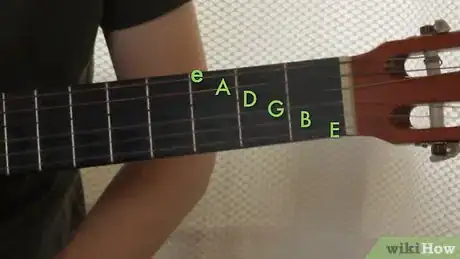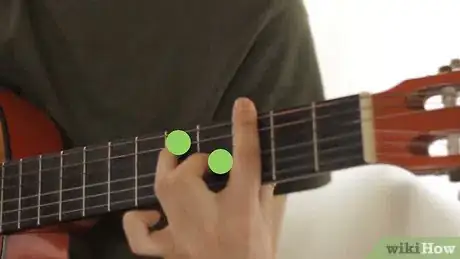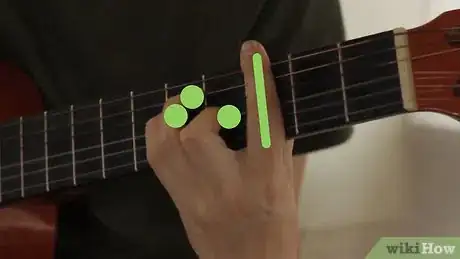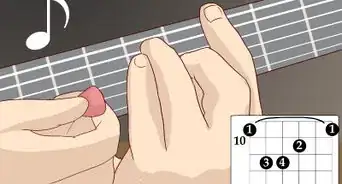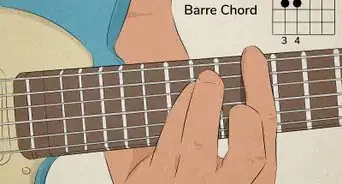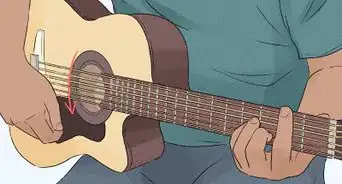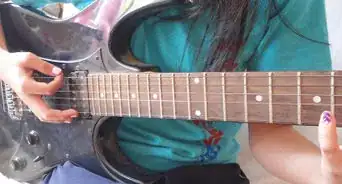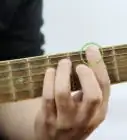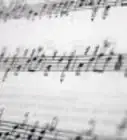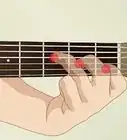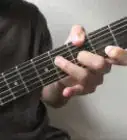This article was co-authored by Nicolas Adams and by wikiHow staff writer, Jennifer Mueller, JD. Nicolas Adams is a 5th generation musician of Serbian Gypsy descent and the lead guitarist of the band Gypsy Tribe. Based in the San Francisco Bay Area, Nicolas specializes in Rumba Flamenco and Gypsy jazz and playing the guitar, Bouzouki, Balalaika, and piano.
This article has been viewed 427,127 times.
G major is a key chord used in everything from pop and rock to hip-hop and blues. It’s typically one of the first chords you’ll learn about when you start playing guitar and, thankfully, it’s perhaps the easiest to master.
Steps
Learning the Basic Chord
-
1Review the names of strings, frets, and notes. If you're new to guitar, you need to get a handle on the basic terminology that is used with guitars before you set out to learn chords. You can find simple introductions by doing an online search.
- Strings count from the bottom up. The thinnest string is the first string, and the thickest is the sixth string. The first string is high E, the second is B, the third is G, the fourth is D, the fifth is A, and the sixth is low E. You may want to create a mnemonic to help you memorize the names of the strings.
- Frets are the metal strips down the neck of your guitar. If you're a right-handed guitarist, the first fret is the furthest to your left. The next closest to you is the second, the next one down the third, and so on down the neck of your guitar.
- You also should keep in mind how fingers are typically numbered on chord diagrams. Your index finger will be "1," your middle finger is "2," your ring finger is "3," and your pinkie is "4." Your thumb is not numbered. While this may seem obvious, it can throw you off if you're used to thinking of your thumb as your first finger.
-
2Make sure you guitar is tuned. You also can purchase an electronic tuner or use audio guides you can find on the internet. Just do a search for "acoustic guitar tuner."[1]
- There also are free and paid mobile apps you can download for your phone that will help you tune your guitar. These can be handy if you plan to play or practice your guitar away from home.
- Start with the lowest string and tune it first, then move on to the next thickest string, tuning high E last.
- With time and practice you'll be able to tune your guitar without assistance, because your ear will be able to distinguish the correct note.
Advertisement -
3Put your ring finger on the third fret of the first string. The third fret of the high E string is a G. This is a root note that gives the chord its "G" character. Pluck the individual string a few times to get used to the sound and make sure it's playing clearly.[2]
-
4Put your index finger on the second fret of the fifth string. The second fret of the A string is a B, one of the three essential notes for a G major chord. Pluck the individual string a few times, then strum from the fifth string down to the first to get used to how these notes sound together.[3]
-
5Put your middle finger on the third fret of the sixth string. The third fret on the low E string is another G, just as the third fret on the high E was G. This means this is another root note. Strum the string alone, then try strumming all together.[4]
-
6Strum all six strings at once to play your chord. G major is an open chord, which means any strings not fretted are played openly. With your fingers in position, strum all six strings several times, making sure the sound is clean.[5]
- If a string sounds muted, you may need to adjust your fingers. Fret with your fingertips, not the pads of your fingers, and keep your hand curled over the neck so you aren't accidentally touching or muting any of the strings.
-
7Practice moving your hand in and out of chord position. Finding the chord shape requires muscle memory, which you must develop through repetition. Remove your hand from the guitar, then place it back with your fingers in chord position.
- If this is the first chord you've learned, have patience. It can be difficult to get used to making chord shapes and you might struggle a little at first, but it will get easier with practice.
- If you know other chords, practice transitioning from the G major chord to another so you can get the hang of moving fingers between positions.
- If your fingers are having trouble quickly reaching the notes, tilt your guitar's neck up in the air. This angle gives your fingers more room to move.
Learning Alternate Fingerings
-
1Try the abbreviated version of the G major chord. By simply placing your middle finger on the third fret of the first string, you can create an abbreviated version of the chord that may be easier for you when transitioning between chords.[6]
- This abbreviated version is not an open chord. You do not strum the sixth, fifth, or fourth strings of the guitar. Only strum the third, second, and first strings.
-
2Play the "rock" G for a richer, deeper sound. Make the basic G major chord shape, then place your pinkie on the third fret of the second string. This adds another D to your chord and gives your strumming a slightly fuller sound.[7]
- Some guitarists find it more comfortable to switch their pinkie and ring fingers. Find the shape that is comfortable for you.
-
3Use your pinkie on the high E string. While the standard fingering of a G major chord puts your ring finger on the high E, you may find it more comfortable to put your pinkie on the high E, using your ring finger on the low E and your middle finger on the A.
-
4Use a D chord shape at the seventh fret. If you know how to make the shape of a D chord, moving your fingers to the seventh fret with your fingers fretting the highest three strings also will produce a G chord.[8]
- With the D chord shape, your index and middle fingers are on the seventh fret. Your ring finger is on the eighth fret. Your index finger frets the G, your middle finger frets the high E, and your ring finger frets the B.
-
5Vary it up with a G7 chord. The G7 chord is a bit of a stretch for your fingers, but if you get to the point where you can make this chord shape comfortably, it will provide a bluesier tone to your music.[9]
- Place your middle finger on the second fret of the A string and your ring finger on the third fret of the low E. You'll notice this is a similar shape to the standard G form, just with different fingers.
- Now stretch back your index finger to the first fret of the high E. Remember to keep your hand curled so you don't mute any of the strings.
- Strum all six strings openly to play this chord.
Playing a G Major Barre Chord
-
1Make a bar with your index finger at the third fret. Place your index finger flat over all six strings on your guitar to create a bar that will press down on all strings evenly. Make sure your finger is as close to the fret as possible without being on top of it.[10]
- Roll your finger onto its side a bit, don't just lay it flat. The tip of your finger should extend over the edge of the fretboard.
- You may need to experiment a little moving your wrist around until you find the most comfortable position for you. Make sure you're pinching the neck of the guitar very hard with your thumb so your barre finger stays straight and firm across the strings.
-
2Create an E major chord shape with your remaining fingers. The G major barre chord is part of the E family of barre chords. Since you've barred your guitar at the third fret, making an E major chord shape results in a G major barre chord.[11]
- Place your pinkie on the D string at the fifth fret, your ring finger on the A string at the fifth fret, and your middle finger on the G string at the fourth fret.
-
3Strum all six strings. Once you've got your fingers in place, strum all six strings openly to play the chord. Make sure all strings are vibrating cleanly and there aren't any strings muted or muffled.[12]
- You may want to strum slowly across all six strings to check the sound from each string.
- Make sure your non-barre fingers are curled, so that you're only fretting with your fingertips.
- Keep in mind that it takes a lot of practice to play a barre chord successfully. Don't give up if you find it difficult at first.
Expert Q&A
Did you know you can get expert answers for this article?
Unlock expert answers by supporting wikiHow
-
QuestionHow do you practice playing a G chord?
 Nicolas AdamsNicolas Adams is a 5th generation musician of Serbian Gypsy descent and the lead guitarist of the band Gypsy Tribe. Based in the San Francisco Bay Area, Nicolas specializes in Rumba Flamenco and Gypsy jazz and playing the guitar, Bouzouki, Balalaika, and piano.
Nicolas AdamsNicolas Adams is a 5th generation musician of Serbian Gypsy descent and the lead guitarist of the band Gypsy Tribe. Based in the San Francisco Bay Area, Nicolas specializes in Rumba Flamenco and Gypsy jazz and playing the guitar, Bouzouki, Balalaika, and piano.
Professional Guitarist
-
QuestionHow can I press my finger very lightly on the guitar?
 Community AnswerOnce you're good at pressing the right chords, you'll automatically press lightly when needed. It comes naturally with practice.
Community AnswerOnce you're good at pressing the right chords, you'll automatically press lightly when needed. It comes naturally with practice. -
QuestionMy fingers are not long enough to play G and I have a concert coming up soon, what do I do?
 Community AnswerThere exists two variants to the G chord: the simplified version and closed-chord version. For the simplified variant, allow your finger to rest on the "A" string, thus deafening it. Place your other finger onto the high "E" string. For the closed-chord variant, barre the third fret with your index finger. Then, place your middle finger onto the fourth fret of the "G" string, ring finger onto the fifth fret of the "D" string, and little finger onto the fifth fret of the "A" string. This creates a E chord underneath your barre.
Community AnswerThere exists two variants to the G chord: the simplified version and closed-chord version. For the simplified variant, allow your finger to rest on the "A" string, thus deafening it. Place your other finger onto the high "E" string. For the closed-chord variant, barre the third fret with your index finger. Then, place your middle finger onto the fourth fret of the "G" string, ring finger onto the fifth fret of the "D" string, and little finger onto the fifth fret of the "A" string. This creates a E chord underneath your barre.
References
- ↑ http://howtotuneaguitar.org/tuning/how-to-tune/
- ↑ https://www.jamplay.com/tools/guitar-chords/1-standard/7-g/85-major
- ↑ https://www.jamplay.com/tools/guitar-chords/1-standard/7-g/85-major
- ↑ https://www.jamplay.com/tools/guitar-chords/1-standard/7-g/85-major
- ↑ https://www.jamplay.com/tools/guitar-chords/1-standard/7-g/85-major
- ↑ https://www.jamplay.com/tools/guitar-chords/1-standard/7-g/85-major
- ↑ https://www.jamplay.com/tools/guitar-chords/1-standard/7-g/85-major
- ↑ https://www.jamplay.com/tools/guitar-chords/1-standard/7-g/85-major
- ↑ https://www.justinguitar.com/en/BC-141-G7B7C7-chord.php
About This Article
To play a G major chord, start by placing your ring finger on the third fret of the first string. Then, place your index finger on the second fret of the fifth string and your middle finger on the third fret of the sixth string. Once your fingers are in place, strum all 6 strings at once to play the G major chord. For tips from our reviewer on how to use alternate fingering methods, or to learn how to play the G major barre chord, read on!
